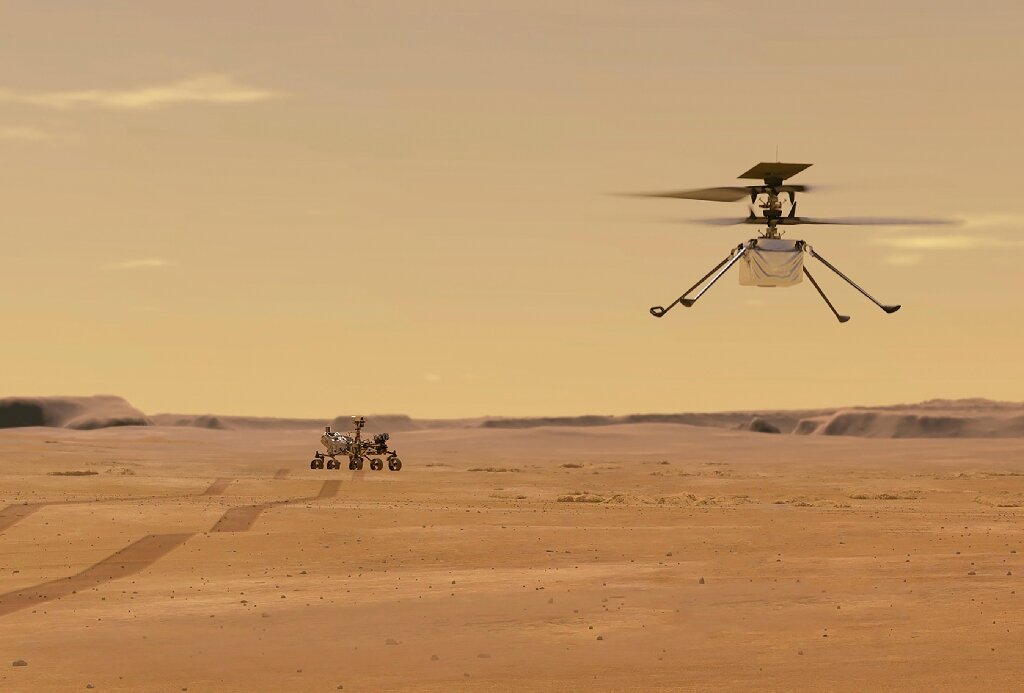
It is 3:15 am PDT/6:15 am EDT, I am up before the sun finding the video feed from the Jet Propulsion Lab (JPL) in Southern California, that is, the NASA feed of the first powered and controlled flight of an aircraft on another planet. Ingenuity, the four-pound “rotary drone that could,” is expected to fly this morning. This is the event that has been deemed the Wright Brothers moment for Mars, and I want to see history in the making.
Why is this such a big deal? It is easy to fly a drone on earth and anyone can buy one at the local electronics shop and fly it around their home on earth. We are very familiar with using our thick earth atmosphere to move things around while using the air for thrust, lift, and drag. On earth, one can stick a hand out the window of a car travelling at 100 km/hr and feel these forces of flight. We can use the wind to fly a kite; birds use the air to lift off, hover in place, dive, and travel great distances; we use the principles of flight to journey to Europe for a vacation; and we use our comparatively thick, soupy, dense, atmosphere to lift our drones into the sky for fun and for real estate videos. But on Mars, the air is anything but dense. At its thickest it is about 1% of that of Earth’s atmosphere. An average air pressure on Earth is around 1000 millibars and less than 10 millibars on Mars.
So, to fly a helicopter on Mars you need rotors that are shaped just right for maximum lift and they must travel very fast. Ingenuity’s blades rotate at around 2500 to 3000 rpm compared to an Earth helicopter’s rotors which spin at around 400 to 500 rpm. Ingenuity weighs only 1.8 kg in earth gravity and about 0.7 kg on Mars and so, there is not much weight that needs to be lifted, yet this was one aspect of the copter that had to be meticulously guarded to ensure the weight did not creep up and become greater than the lift available from the rotors.
Okay, not everyone will find such details of interest. I am just nerdy enough, just science geek enough, to want to see the data come in – in real-time. After all, I am one of a few people who have spent hours on the “Apollo 11 in real-time” website (https://apolloinrealtime.org/11/) listening to the transmission of voice and telemetry between Houston Ground Control and the three Apollo 11 astronauts. Perhaps only someone as science-oriented as me would be interested in watching the looks on the faces of the engineers, astronauts, and scientists in the room as they watched the Ingenuity data come in from the NASA Deep Space Network communications system.
There was of course the much-needed television anchor personality and the media go-between who helped interpret the results for the general public, but I found myself hoping that they would soon be finished explaining everything for the fourth time and would stop taking questions from a somewhat less scientifically oriented public, so that I could watch and hear the specialists in the room: Downlink Lead; Rotors Lead; Batteries Lead; Altimeter Lead. And here is a sample of what we got to see and hear as we tuned in live,
“This is downlink, we are beginning to see data products.” Downlink Lead,
“Rotor motors appear healthy, all actuators appear healthy.” Rotors Lead,
“Batteries appear healthy.” Batteries Lead,
“Ingenuity is reporting: having performed spin-up, takeoff, flight, hover, descent, landing, touchdown, and spin-down, altimeter data confirms, that Ingenuity has performed its first flight – first flight of a powered flight on another planet.” Chief pilot, Håvard Fjær Grip.
At which point, all had big smiles on their faces and a series of whoops and cheers erupted in the room. It gave me goosebumps. The team[1] is an impressive group of specialists from around the world and each one a leader in their specific field. It was great to see the diversity of nationalities, genders, and scientific and engineering disciplines in the room – all of them smiling and cheering one another on.
As the group congratulated each other on work well done, Project Manager MiMi Aung expressed a desire to hug each one on the team and then called on everyone to enjoy the moment before getting back to work. This was only the beginning and there are more flights yet to come. Just out of the reach of the camera, one could see part of the JPL motto on the wall: “Dare Mighty Things.” Indeed, they did dare and, on that day, daring dreams came true.
[1] Dave Lavery is the program executive for the Ingenuity Mars Helicopter, MiMi Aung is the project manager, and Bob Balaram is chief engineer.